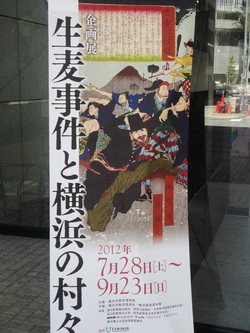
The Yokohama History Museum recently held an exhibition on the “Namamugi Incident”, in which the British merchant Charles Richardson was murdered in 1862 just outside the village of Namamugi, near Yokohama, by samurai of the Satsuma clan. It is a well-known historical event in Japan as it led to the Anglo-Satsuma conflict of the following year, during which the Royal Navy burned down most of the Satsuma capital Kagoshima in southern Kyushu.
The Namamugi Incident is less well known in the West, but I am hoping all that will change as it features prominently in my novel “Milligan and the Samurai Rebels”, available now from all good online bookshops (as long they are called Amazon). The established history - which does not record Milligan’s presence at Namamugi nor his poor horsemanship that brought about the whole murderous exchange - is that Richardson and three others from the Foreign Settlement at Yokohama went for a ride in the surrounding countryside and at Namamugi on the great East-Wast highway, the Tokaido, they encountered the party accompanying a Satsuma lord on his way back from Edo (as Tokyo was then known). Japanese practice in such a circumstance was to dismount, kneel and lower one’s forehead to the floor until the lord had passed. Aware of this expectation but unwilling to fulfill it, the Westerners were attacked by samurai retainers and Richardson was killed. His body, when later discovered, was horribly mutilated with dozens of sword cuts.
Needless to say the British authorities and the other Westerners were less than amused, and a few months later a punitive mission to Satsuma was undertaken by British forces. Ironically, this conflict brought Britain and Satsuma closer together, with the former becoming the latter’s main source of modern arms; weapons which were ultimately used to topple the Tokugawa Shogunate and usher in Imperial rule and modern Japan in 1868. You might therefore say that the main loser that day at Namamugi was the Shogun, after poor Richardson himself of course.
The Yokohama exhibition itself consists mostly of documents from the time, with the odd period photograph thrown in. Not wildly exciting for the casual tourist, and with no English explanations you have to read Japanese to get anything from it. I liked the description of the incident as “a result of a number of cultural misunderstandings”.
Well, perhaps. Westerners’ cultural misunderstandings in Japan, such as not taking your shoes off when entering a house, tend to cause only minor offence. They don’t usually lead to bloody murder, but then times have changed and I guess we should be thankful for that.
The Namamugi Incident is less well known in the West, but I am hoping all that will change as it features prominently in my novel “Milligan and the Samurai Rebels”, available now from all good online bookshops (as long they are called Amazon). The established history - which does not record Milligan’s presence at Namamugi nor his poor horsemanship that brought about the whole murderous exchange - is that Richardson and three others from the Foreign Settlement at Yokohama went for a ride in the surrounding countryside and at Namamugi on the great East-Wast highway, the Tokaido, they encountered the party accompanying a Satsuma lord on his way back from Edo (as Tokyo was then known). Japanese practice in such a circumstance was to dismount, kneel and lower one’s forehead to the floor until the lord had passed. Aware of this expectation but unwilling to fulfill it, the Westerners were attacked by samurai retainers and Richardson was killed. His body, when later discovered, was horribly mutilated with dozens of sword cuts.
Needless to say the British authorities and the other Westerners were less than amused, and a few months later a punitive mission to Satsuma was undertaken by British forces. Ironically, this conflict brought Britain and Satsuma closer together, with the former becoming the latter’s main source of modern arms; weapons which were ultimately used to topple the Tokugawa Shogunate and usher in Imperial rule and modern Japan in 1868. You might therefore say that the main loser that day at Namamugi was the Shogun, after poor Richardson himself of course.
The Yokohama exhibition itself consists mostly of documents from the time, with the odd period photograph thrown in. Not wildly exciting for the casual tourist, and with no English explanations you have to read Japanese to get anything from it. I liked the description of the incident as “a result of a number of cultural misunderstandings”.
Well, perhaps. Westerners’ cultural misunderstandings in Japan, such as not taking your shoes off when entering a house, tend to cause only minor offence. They don’t usually lead to bloody murder, but then times have changed and I guess we should be thankful for that.
 RSSフィード
RSSフィード
